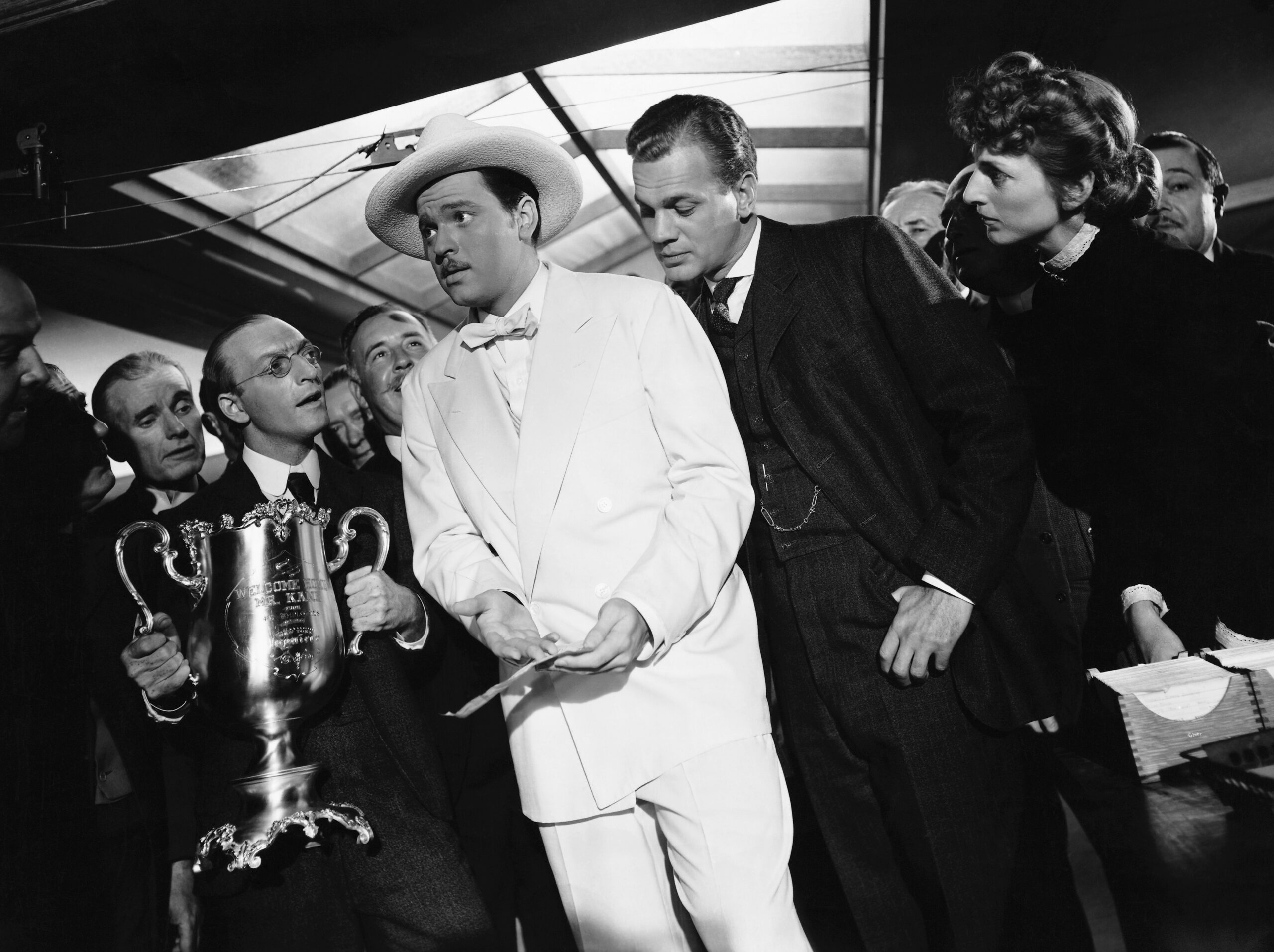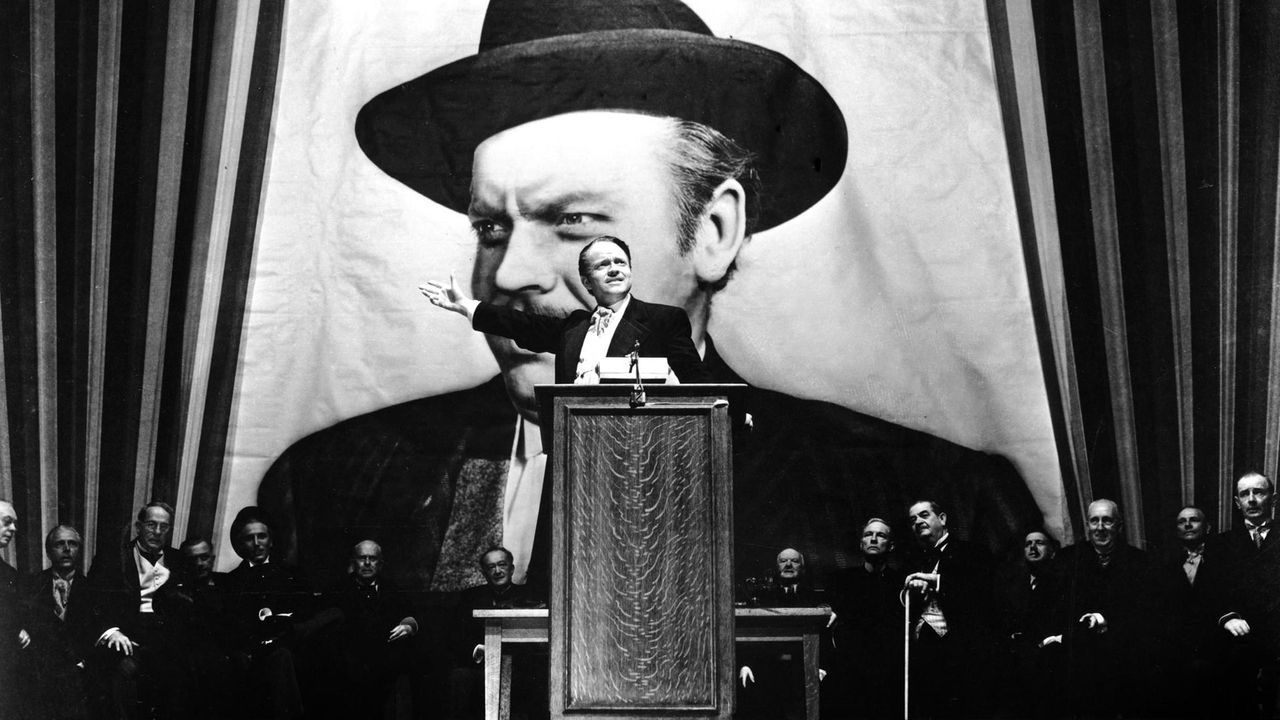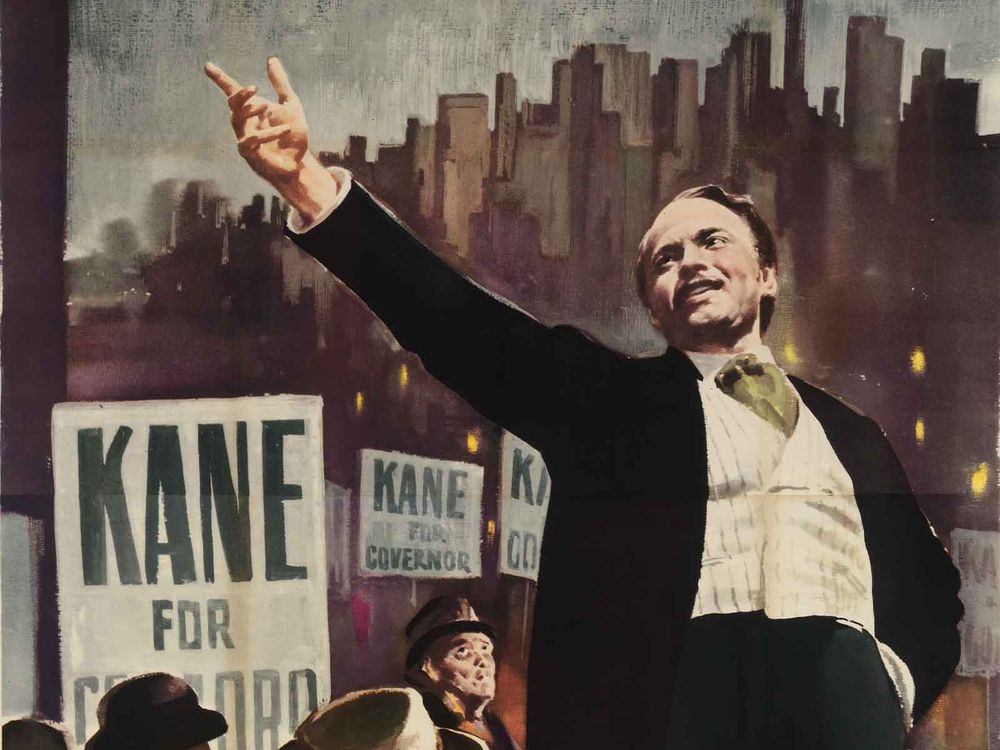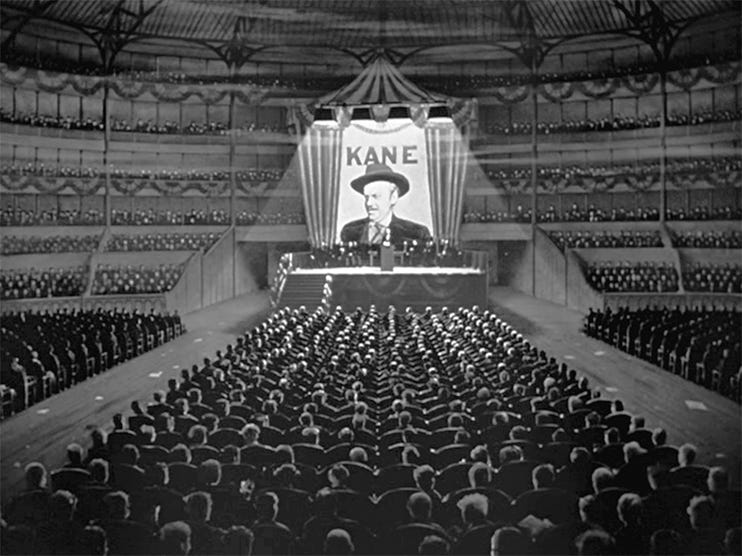Citizen Kane narrates the life of Charles Foster Kane, a wealthy newspaperman. The movie begins with the demise of Kane (after which point an investigation is launched to uncover the significance behind his cryptic last words – ‘Rosebud’) The story then continues, with the audience walking them through Kane’s life journey; from his becoming to power, followed by his romances and finally dismantling of empire.
The film uses a series of flashbacks and interviews with those who knew Kane best to show him for the complex, three-dimensional man he was: someone who had everything but still found happiness elusive. Although the story is edited from many perspectives to create a non linear narrative, every man gives his unique outlook on who Charles Foster Kane truly was.
The mystery of “Rosebud” is a narrative mechanism that the movie uses to drive them through said story. As the wdbos investigators dig into all facets of Kane’s life, we are left to think about deeper questions and themes such as what really constitutes legacy and is happiness truly that ill-attainable.
The climactic revelation of the meaning behind “Rosebud” is a moving reminder that while wealth, power and material goods may be ephemeral, our human need for love vs. belonging endures forever. Citizen Kane– Tale of mysterious and fascinating character In my point o very well-knowledgeable legendary movie Citizen Kane is a real investigation regarding human encounters, the wildest story person to make oneself or someone else responsible does not try something on…assist.streaming.
Historical Significance of Citizen Kane
It is widely regarded as one of the greatest films ever made, and I am sure most critics would say it is a landmark in cinema. The movie, with which precocious Orson Welles made his directorial debut and severed from standard Hollywood narrative practice of the era.
His innovative narrative techniques such as flashbacks, unconventional editing and sound techniques have been credited with defining the language of cinema. Not only did these techniques help enrich the narrative, but they also helped to pull audiences into Kane’s life as an opposite of facing them with a complete puzzle that just needed fitting together.
The technical achievements of the film were as innovative. The technique of deep focus cinematography, in which both the foreground and background were kept sharply indistinct on screen was never seen before. These visual aesthetics were enhanced by the groundbreaking lighting, camera angles and editing techniques employed in the film which would set a new benchmark for filmmaking excellence.
It also played an important role in presenting the glamour and power of money on screen, causing a tectonic shift. And with the movie’s scathing indictment of money and power in Hollywood — a rarity for that era, when Tinseltown often seemed afraid to bite its hand even if it knew it should have. Welles willingness to go against the grain and delve into the darker side of human nature is a hallmark in his filmography, showing that Welles wanted to make an impact with The Magnificent Ambersons that would change filmmaking for years after its release.
The lasting impact that the movie has left is a sign of its cultural importance as well as artistic. Over the years, “Citizen Kane” has been well scrutinized and gnawed upon by academics to a fare-thee-well; an infinite number of ream-covering essays (both feature-length critical analyses) have pertained to it. Its impact on the medium of film is indelible, and it remains to this day one of many key defining films that furthered cinema as an art form.

Analysis of the Cinematography in Citizen Kane
Among the most notable aspects of Citizen Kane is its cinematography, which was ground-breaking for Welles and his team of talented collaborators in terms of what they were able to achieve with sight within their medium. The opening shot of Kane’s Xanadu estate has become one of the most iconic in cinema history, and all throughout “Citizen Kane” it is brazenly clear that Welles was showcasing a fully formed style full stop.
The style of deep focus is one of the more notable features that stands out visually through this film, it consists on having both foreground and background in front clear emphasized simultaneously. This technique-first employed by master cinematographer Gregg Toland, above with Orson Welles on Citizen Kane-is radical in that it creates the illusion of three dimensions and an abiding sense of verisimilitude such as had never before been seen during Hollywood’s classical cinema period. These deep focus shots, in “Citizen Kane” are both visually striking (despite efforts to make them nonchalant) and also seem like a suggestion that audiences need an invitation to partake of the multiple narratives.
The lighting in the film is as good; Welles and Toland use a variety of methods to create an overcast, moody look for their visuals. It gives that dark look to the film with heavy lighting contrasts as seen in multiple scenes. The lighting, too, illuminates the film’s power corrupts theme and its chase of happiness will end now motif; with the chiaroscuro playing in line to reflect Kane as a character, and his world as well.
What also stands out in “Citizen Kane” is its camera work which for their time, were revolutionary and aggressive. Welles and Toland use low angle shots, high-angle shots and tracking to fill the frames with a sense of movement. The camera is typically employed to focus the audience’s gaze, directing it toward important details in a scene and adding visual rhythm that informs the narrative.
Fast-paced montage, editing are the another lens of cinematic brilliance Dare I say one aspect of this film. The non linear story made up mainly of the photos and experimental use of a different POVs is brilliantly tied up by editing. This creates a sense of enigma that hooks the audience into following where each scene leads to, and makes the transitions between them seem so fluent if not unlooked for.
Collectively, this is what the cinematography of Citizen Kane: Or What went on in front and behind the camera? While the visual style of his next film does more than simply enrich its story, it also mirrors other concepts and themes that Khondji aims to explore in it. A film that remains a cinematic revelation and inspiration not just to audiences, but also filmmakers.
Themes and Symbolism in Citizen Kane
Everyone knows Citizen Kane, but at the very core of Orson Welles’ epic piece lies an intricate web of thematic subtext and visual metaphor that has seduced cineastes for years. Using symbol and metaphor, the film collates a myriad of levels to circle themes of human ambiguity, riches that bankrupts any soul gifted with it not earned or granted from above, joy forever does teasing elude.
One of the major undertones in this movie is about craving for power and how it ruins a persons life. The film revolves around the character of Charles Foster Kane, a man who becomes inordinately rich and powerful only to end up alone with everything else having vanished. The film’s “Rosebud” motif, as symbolizing the innocence and childhood of Kane which he could never reclaim through power alone is a powerful allegory for how chasing after power can gnaw at what originally made us happy.
A couple of recurring motifs in the movie are related to memory, and how our past experiences can have a lasting impact upon both our current situation as well as future outlook. Through its non-linear narrative, weaving in and out of flashbacks from multiple points of view, the film deliberately requires audience participation to reconstruct different pieces Kane’s life into a more holistic account. That motif is then doubled down upon in the movie, using metaphors like a snow globe standing for how happiness comes and goes.
This is largely due to the way in which love and relationships are depicted throughout; central explorations of any film with rich thematic content. The character of Susan Alexander, the second wife Kane ultimately marries for reasons more to do with his relentless ambition than any actual love or kinship between them. This twist adds an ironic layer of tragedy to Kane’s downfall and reminds the viewer that his collapse was ultimately due in part on how power can penetrate even a marriage born out of desire.
Symbolism is another part of the thematic depth that this movie has created. The character of Kane is a deep and many layered one that only symbolizes pieces of the human experience while also defining what power, money, and ambition do to someone. These themes are complemented by symbolic imagery, such as the Xanadu estate and recurring “Rosebud” motif in the film building a depth of meaning remain vivid after years of study to both pull viewers in emotionally, then follow up with questions that break into new mental territory.
Thus, the themes and symbolism of Citizen Kane illustrate its place as a cinematic workhorse. It’s a profound story on what it means to be human, the intoxicating effects of power and how fleeting happiness can really be: they are all part just a brilliant piece of storytelling writh from visual language that makes this film continue speaking to both audiences and critics nearly 40 years after the fact.

The Impact of Citizen Kane on the Film Industry
The impact of “Citizen Kane” on the film industry cannot be overstated. Orson Welles’ directorial debut was a groundbreaking work that forever changed the way films were made and perceived. The film’s innovative techniques, bold storytelling, and profound themes left an indelible mark on the industry, influencing generations of filmmakers and shaping the course of cinematic history.
One of the most significant ways in which “Citizen Kane” impacted the film industry was its revolutionary approach to storytelling. The film’s non-linear structure, with its use of flashbacks and multiple perspectives, challenged the traditional linear narrative that had dominated Hollywood at the time. This innovative approach not only enhanced the film’s thematic depth but also invited the audience to actively engage with the story, piecing together the puzzle of Kane’s life.
The film’s technical achievements were equally groundbreaking, with Welles and his team of collaborators pushing the boundaries of what was possible in the medium. The use of deep focus cinematography, chiaroscuro lighting, and dynamic camerawork created a visual style that was unparalleled in the era of classical Hollywood cinema. These techniques not only enhanced the film’s aesthetic appeal but also served to immerse the audience in the narrative, creating a sense of depth and realism that was unprecedented.
The impact of “Citizen Kane” on the film industry can also be seen in the way it challenged the status quo and tackled weighty themes that were often avoided by Hollywood at the time. The film’s critical examination of the corrupting influence of power and wealth, as well as its exploration of the complexities of the human experience, were bold and innovative moves that set it apart from the more conventional narratives of the era. This willingness to explore the darker aspects of human nature and challenge the established norms of the industry paved the way for a new generation of filmmakers who would follow in Welles’ footsteps.
The legacy of “Citizen Kane” can be seen in the countless films that have been influenced by its innovative techniques and thematic depth. From the works of directors like Alfred Hitchcock and Akira Kurosawa to the more contemporary films of directors like Martin Scorsese and David Fincher, the impact of “Citizen Kane” can be felt in the way they approach storytelling, cinematography, and the exploration of complex themes.
In the decades since its release, “Citizen Kane” has remained a touchstone of cinematic excellence, a film that continues to be studied, analyzed, and celebrated by filmmakers, critics, and audiences alike. Its enduring legacy is a testament to the power of the medium and the transformative impact that a single work of art can have on an entire industry.
Reviews and Reception of Citizen Kane
The release of “Citizen Kane” in 1941 was met with a mixed response, with some critics hailing it as a masterpiece while others were more skeptical of its unconventional approach. However, over the years, the film has come to be widely regarded as one of the greatest works of cinema ever produced, with its critical reception and cultural impact only growing stronger with time.
One of the most notable aspects of the film’s initial reception was the controversy surrounding its thinly veiled portrayal of the life of publishing magnate William Randolph Hearst. Hearst was so incensed by the film’s depiction of a character based on him that he used his considerable influence to try and prevent the film’s release, even going so far as to threaten legal action. This controversy only served to heighten the film’s profile, however, and contributed to the sense of intrigue and mystery that surrounded it.
Despite the initial controversy, many critics recognized the film’s technical and artistic brilliance. The New York Times’ review, written by Bosley Crowther, praised the film’s “dazzling display of technical resources” and its “brilliant performances.” Similarly, the critic James Agee, writing for The Nation, described the film as a “breakthrough in the motion picture’s techniques” and a “triumph over the familiar devices of the trade.”
Over the years, the critical reception of “Citizen Kane” has only grown more enthusiastic and effusive. In 1962, the film was selected by the prestigious Sight and Sound critics’ poll as the greatest film of all time, a distinction it would hold for several decades. Subsequent polls have continued to rank the film among the top works of cinema, with the British Film Institute’s 2012 poll placing it at number one on their list of the greatest films ever made.
The film’s cultural impact has also been immense, with its influence extending far beyond the world of cinema. The iconic image of Kane uttering the word “Rosebud” on his deathbed has become one of the most recognizable and enduring moments in film history, while the film’s exploration of themes like power, wealth, and the human condition have made it a subject of endless academic and critical analysis.
Today, “Citizen Kane” is widely regarded as a masterpiece of the medium, a film that has not only stood the test of time but has also continued to inspire and influence generations of filmmakers and audiences. Its legacy as a groundbreaking work of art and a cultural touchstone is a testament to the enduring power of cinema and the transformative impact that a single film can have on the industry and the world at large.

The Legacy of Citizen Kane
The legacy of “Citizen Kane” is one that extends far beyond the confines of the film industry, touching on a wide range of cultural, artistic, and societal themes that continue to resonate with audiences and critics alike. As a work of art, the film has been celebrated for its technical innovation, its narrative complexity, and its profound exploration of the human experience. But its impact extends even further, shaping the way we think about power, wealth, and the pursuit of happiness.
One of the most enduring aspects of “Citizen Kane’s” legacy is its influence on the art of filmmaking itself. The film’s innovative techniques, such as its use of deep focus cinematography, non-linear storytelling, and dynamic camerawork, have become staples of the medium, inspiring generations of filmmakers to push the boundaries of what is possible on the screen. The film’s impact can be seen in the work of directors as diverse as Alfred Hitchcock, Stanley Kubrick, and Martin Scorsese, all of whom have drawn inspiration from Welles’ groundbreaking approach to cinematic storytelling.
But the legacy of “Citizen Kane” extends beyond the realm of filmmaking, touching on broader cultural and societal themes that continue to resonate with audiences today. The film’s exploration of the corrupting influence of power and wealth, and its examination of the elusive nature of happiness, have made it a subject of endless academic and critical analysis. The character of Charles Foster Kane has become a symbol of the American dream gone awry, a cautionary tale of the dangers of unchecked ambition and the pursuit of material success at the expense of personal fulfillment.
The film’s impact on the way we perceive and understand the world around us is also undeniable. The character of Kane, with his vast wealth and influence, serves as a microcosm of the broader social and economic structures that shape our lives. The film’s exploration of the ways in which power can be wielded and abused, and the ways in which wealth can isolate and alienate individuals, have made it a touchstone for discussions of inequality, corruption, and the nature of modern society.
But perhaps the most enduring aspect of “Citizen Kane’s” legacy is its ability to captivate and inspire audiences across generations. The film’s timeless themes, its technical brilliance, and its enduring cultural relevance have made it a must-see for cinephiles and casual viewers alike. The film’s ability to continue to resonate with audiences, even nearly eight decades after its release, is a testament to its status as a true masterpiece of the medium.
In the end, the legacy of “Citizen Kane” is one that extends far beyond the confines of the film industry, touching on a wide range of cultural, artistic, and societal themes that continue to shape the way we think about the world around us. As a work of art, it stands as a testament to the power of cinema to captivate, challenge, and transform us, and its enduring impact on the medium and on the broader cultural landscape is a testament to its status as a true cinematic masterpiece. If you like reading this article then please consider reading our article about Africa.

